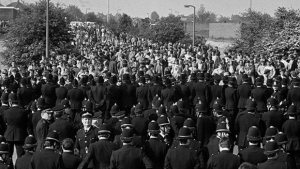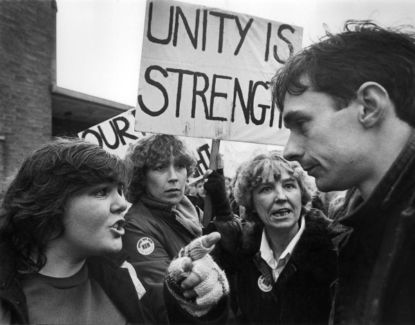Owen Gower’s debut feature film offers a narrative of the 1984-85 miners strike, the loss of which has triggered three subsequent decades of neoliberal power consolidation. If history belongs to the winners, then this film proves that at certain points the winners will have to make concessions. Both the Evening Standard and the Daily Express have given it four-star reviews, while even the Mail on Sunday has stated “watching the empty steel mills, abandoned shipyards and the scrubland where many communities once flourished you can only agree with one ex-miner who concluded ‘we lost, but we were right.’”
That the same media apparatus which spent the best part of a decade helping to destroy the NUM (National Union of Mineworkers) and its leaders is now lauding this film, while congruently working in the same old ways to close down contemporary protest, indicates their view of historic events as neutral. That is, lacking the capability of current protest movements to inflict damage on established power. In a similar vein, while this film is a commendable attempt to foster a narrative that opposes that which history’s “winners” would seek to maintain, it substitutes the threat contained within its title (“Still…”) for a nostalgia that reduces its capacity to effect neo-liberal dominance. Ultimately, the formal structures inside which it confines itself serve to reduce the militancy of its subject matter. This review will look at the ways Still the Enemy Within remains within acceptable boundaries, suggesting that a few more steps towards advocacy, and away from nostalgia, may have lead to weaker reviews from the right wing press.
Primarily, Still uses dominant filmic forms and a restrictive, linear narrative, which tempers the militancy of its subject matter. If one purpose of documentary is to inject marginalised narratives into popular discourse, then another must be to push against the formal boundaries within which these narratives are articulated. The problem is one of remaining accessible to an audience largely used to normalised documentary forms while pushing toward the political and aesthetic avant-garde. This film fails in the latter respect. Its self-confinement within these formal boundaries gives rise to a series of problems.
 The narrative structure is a chronological ordering of events, a concise timeline of the strike that becomes hermetically sealed from the present, based as it is on a conception of history that consigns events to the past, as opposed to making manifest their resonances in contemporary political struggles. This, after all, is what makes history dangerous. While the film attempts to break through this barrier towards the end by giving a brief nod to today’s anti-austerity campaigns, this remains at the level of the sentimental as opposed to the informative. The wisdom that must have been garnered throughout the strike by the miners and their affiliates would have been better expressed in a discussion of the methods and tactics employed, as well as advocacy for similar actions today. Such a pedagogical dimension would constitute a contribution to praxis, and a much needed re-introduction of the strikers’ militant discourse into the public sphere, which would be well facilitated given the films accessible form.
The narrative structure is a chronological ordering of events, a concise timeline of the strike that becomes hermetically sealed from the present, based as it is on a conception of history that consigns events to the past, as opposed to making manifest their resonances in contemporary political struggles. This, after all, is what makes history dangerous. While the film attempts to break through this barrier towards the end by giving a brief nod to today’s anti-austerity campaigns, this remains at the level of the sentimental as opposed to the informative. The wisdom that must have been garnered throughout the strike by the miners and their affiliates would have been better expressed in a discussion of the methods and tactics employed, as well as advocacy for similar actions today. Such a pedagogical dimension would constitute a contribution to praxis, and a much needed re-introduction of the strikers’ militant discourse into the public sphere, which would be well facilitated given the films accessible form.
 Furthering its value as a tool to be used in an ongoing struggle, the film could have utilised the findings of years worth of investigative journalism to highlight the confluences between different sections of the state apparatus. As has been shown by Milne (1995) the responsibility for the destruction of mining communities extends to the entire state-corporate nexus. A particularly drastic, though relatively unknown, measure has been the employment of MI5 to quell “domestic dissidents,” a project that has been ongoing since the 1960s (at least), but accelerated under Thatcher, given that “the cosy relationship between elements of the intelligence services and the right wing of the Tory party proved to be a vital lubricant in smoothing Thatcher’s rise to power” (Milne 1995: 341). In this context the filmic form remains important, as it is, potentially, a language that resists the imposition of meaning that is the purpose of these state machinations. As Hall explains:
Furthering its value as a tool to be used in an ongoing struggle, the film could have utilised the findings of years worth of investigative journalism to highlight the confluences between different sections of the state apparatus. As has been shown by Milne (1995) the responsibility for the destruction of mining communities extends to the entire state-corporate nexus. A particularly drastic, though relatively unknown, measure has been the employment of MI5 to quell “domestic dissidents,” a project that has been ongoing since the 1960s (at least), but accelerated under Thatcher, given that “the cosy relationship between elements of the intelligence services and the right wing of the Tory party proved to be a vital lubricant in smoothing Thatcher’s rise to power” (Milne 1995: 341). In this context the filmic form remains important, as it is, potentially, a language that resists the imposition of meaning that is the purpose of these state machinations. As Hall explains:
“The moment of power is in the historically situated intervention of ideology in practices of signification. That is the moment of overdetermination […] when the powerful want to bring history to an end […] it is the way class interests and other social forces attempt to intervene in the sphere of signification, to articulate or harness it to a particular project, to hegemonies.” (Hall 1997: 30-31)
The use of secret security services to bully, hound and smear those on the left is an example of this attempt to halt the generation of new meanings. Another is the ways in which filmic forms are defined by a neutralising “professionalism” (Espinosa 1979). In both cases control is exerted over what information enters the public sphere, and in what ways. It is one of the priorities of radical film to subvert both barriers.
 Neglecting these sorts of complexities is, perhaps, the price the film pays for its accessibility. However, opportunities for a more in-depth explanation of events are routinely missed, particularly with respect to the failure of the TUC (Trades Union Congress) and Labour Party to support the miners strike. This is exemplified by a brief piece of archive footage showing Neil Kinnock walking away from the camera in silence. Arguably this is all that needs to be said about Neil Kinnock. However, some analysis on the way the “leaders” of social democracy tend to become managers of those they represent would have been useful. Instead the film over-uses the musical-montage form, inserting one of these sequences in its depiction of each historical juncture or aspect of the strike. The heights of sentimentality are reached in one of the opening sequences that shows archive footage of working miners in the 1970s and early 80s over a benign soundtrack that sounds as if it was taken from a pre WW2 BBC radio broadcast. There is nothing wrong with this rather clumsy attempt to instill emotion as such. But it reflects an almost thoughtless adherence to established filmic norms that, unfortunately, is a consistent feature of Still the Enemy Within. In future I hope to see Gower’s films leaving their Mail on Sunday reviewers shocked and appalled.
Neglecting these sorts of complexities is, perhaps, the price the film pays for its accessibility. However, opportunities for a more in-depth explanation of events are routinely missed, particularly with respect to the failure of the TUC (Trades Union Congress) and Labour Party to support the miners strike. This is exemplified by a brief piece of archive footage showing Neil Kinnock walking away from the camera in silence. Arguably this is all that needs to be said about Neil Kinnock. However, some analysis on the way the “leaders” of social democracy tend to become managers of those they represent would have been useful. Instead the film over-uses the musical-montage form, inserting one of these sequences in its depiction of each historical juncture or aspect of the strike. The heights of sentimentality are reached in one of the opening sequences that shows archive footage of working miners in the 1970s and early 80s over a benign soundtrack that sounds as if it was taken from a pre WW2 BBC radio broadcast. There is nothing wrong with this rather clumsy attempt to instill emotion as such. But it reflects an almost thoughtless adherence to established filmic norms that, unfortunately, is a consistent feature of Still the Enemy Within. In future I hope to see Gower’s films leaving their Mail on Sunday reviewers shocked and appalled.
Anthony Killick is a PhD candidate studying film festivals and politics at Edge Hill University and co-director of the Liverpool Radical Film Festival.
References
Espinosa, Julio García (1979), “For an Imperfect Cinema”, Jump Cut: A Review of Contemporary Media, no. 20, pp. 24-26. Accessed 25 January 2015.
Hall, Stuart (1997), “Culture and Power: Interview with Stuart Hall,” Radical Philosophy 86, November/December, pp. 24-31.
Milne, Seamus (1995) The Enemy Within, London: Pan Books.

